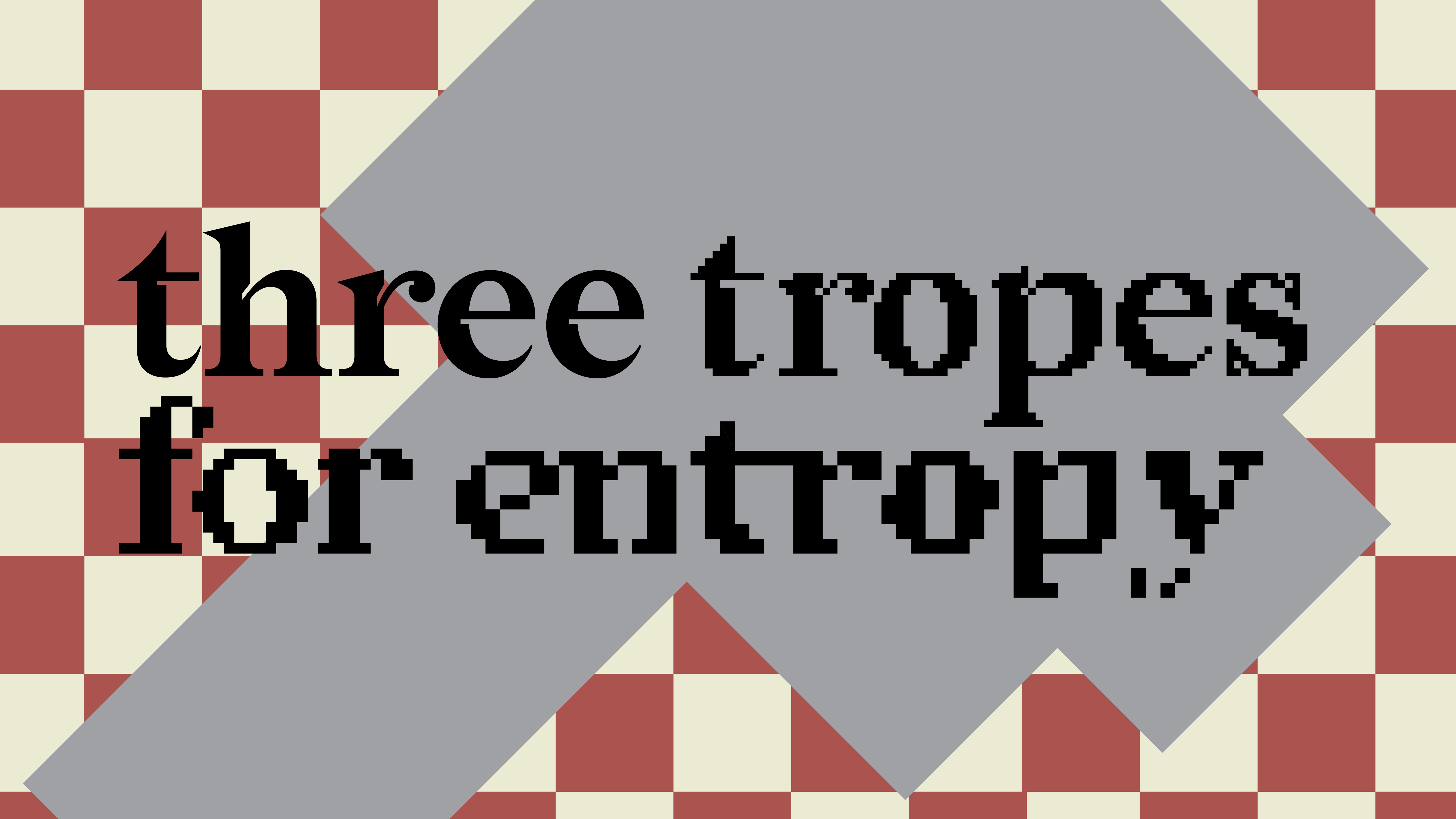
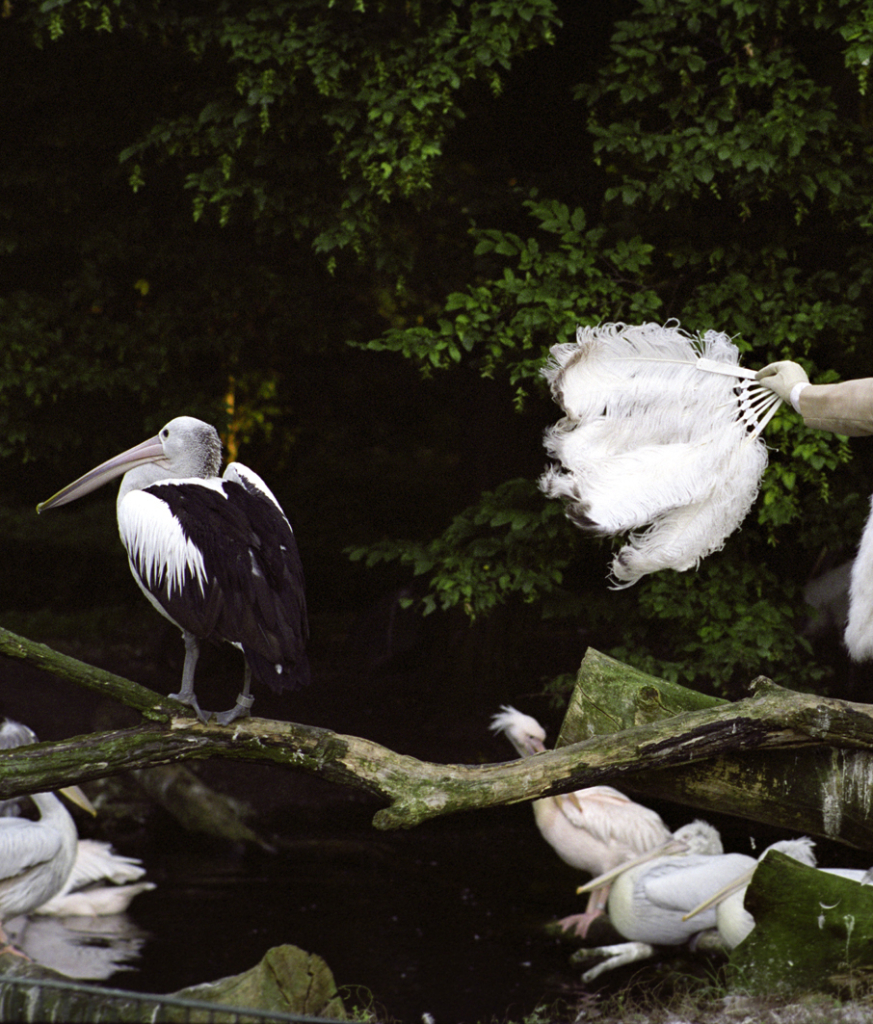
Charming for the Revolution
11.03–02.07.2023
Charming for the Revolution
11.03–02.07.2023

Charming for the Revolution, Pauline Boudry / Renate Lorenz, still. Installation with 16mm/HD, 11 min. 2009. Performance: Werner Hirsch. Courtesy of Ellen de Bruijne Projects Amsterdam and Marcelle Alix Paris.
Jester inaugurates its new programme with the group exhibition Charming for the Revolution*, introducing several major themes and values that underlie Jester’s programme and identity. The exhibition is part of a longer collaboration with artists Carly Rose Bedford, Toon Fibbe, and Pauline Boudry & Renate Lorenz – all of whom present new productions or works adapted to Jester’s unique exhibition space at C-mine.
Charming for the Revolution gives platform to artists who persistently choose to view the world from another perspective and to manipulate, magnify, or on the contrary, disguise things. Their works examine our relationship to labour, history, economy, and materials.
In conjunction with the exhibition, Jester organises a number of public events, including a reading group, a film programme, and a series of talks. More information about the programme will be published soon, on Jester’s new website (coming up in February).
* The title of the exhibition borrows from the film Charming for the Revolution (2009) by Pauline Boudry & Renate Lorenz
Carly Rose Bedford’s work addresses the themes such as LGBTQ+, emancipation, the body vs hierarchical structures and translates them into a multidisciplinary practice. The seemingly recognisable forms and objects incorporated in their installations cannot be easily labelled or interpreted. Bedford rejects normative representation and proposes alternative relationships that we can enter with people, nature, and things around us. Carly Rose Bedford graduated from the Sandberg Institute, Amsterdam. In 2019, they won the MK Awards, followed by several solo presentations in the following years, including Utopian Redux (2020) at TENT Rotterdam.
Pauline Boudry and Renate Lorenz have been working together in Berlin since 2007. They produce installations that choreograph the tension between visibility and opacity. Their films capture performances in front of the camera, often starting with a song, a picture, a film or a score from the near past. They upset normative historical narratives and conventions of spectatorship, as figures and actions across time are staged, layered and re-imagined. Their performers are choreographers, artists and musicians, with whom they are having a long-term conversation about the conditions of performance, the violent history of visibility, the pathologization of bodies, but also about companionship, glamour and resistance. Their sculptures and objects often refer to the potentiality of performance, using materials that connect to props, stages, costumes, microphones, wigs or dance floors.
Recently, they have shown their work at the Crystal Palace – Museo Reina Sofia Madrid, Whitechapel Gallery, London, Hammer Museum Los Angeles, Seoul Museum of Art, Centre Pompidou Paris. Recent solo exhibitions include CA2M Madrid, 2022, Kunstraum Innsbruck, (2021), Frac Rennes (2021), NBK Berlin (2020), Swiss Pavillon, 58th Biennale di Venezia (2019), Julia Stoschek Collection Berlin (2019).
(text: Boudry & Lorenz)
Toon Fibbe uses performance, video, fashion, installation, text and sculpture to get a better grip on the shadowy world of finance and economics. The invention of characters and personas is what drives the production of objects, films and installations. It is precisely thinking through characters that makes it possible to transform the abstractions of the financial world into unexpectedly theatrical works, wherein extravagant stock market traders stagger on high heels and finance is made visible through talking sculptures, body horror and physical – sometimes even literally dripping – images. Fibbe deals with bodily and ghostly metaphors as a way of understanding economic processes – both now and throughout history. His work departs from the idea that political economy has always had an affinity with the ghostly sphere – as seen, for instance, in Adam Smith’s metaphor of the invisible hand or in the writings of Marx, but also in the gothic fiction of the 19th century.
Toon Fibbe graduated from the Piet Zwart Institute and did a postgraduate at the Jan van Eyck. His work has been shown at Wiels, Kunsthuis Syb, M HKA, Nieuwe Vide, M Leuven, and Kunstfort Vijfhuizen, and others.
(text: Toon Fibbe)
Realised with the kind support of the Flemish Community, the city of Genk, and Jester members.
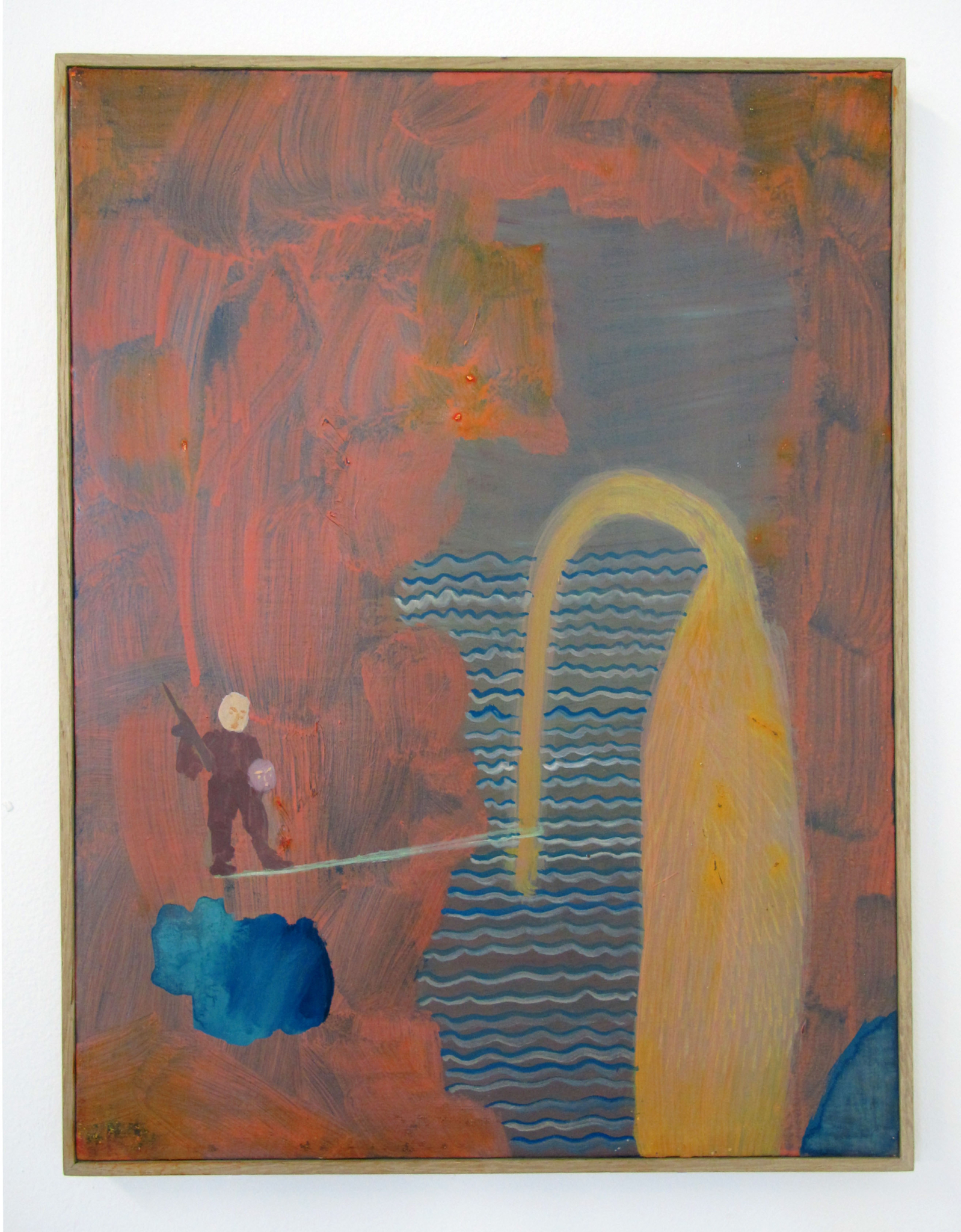
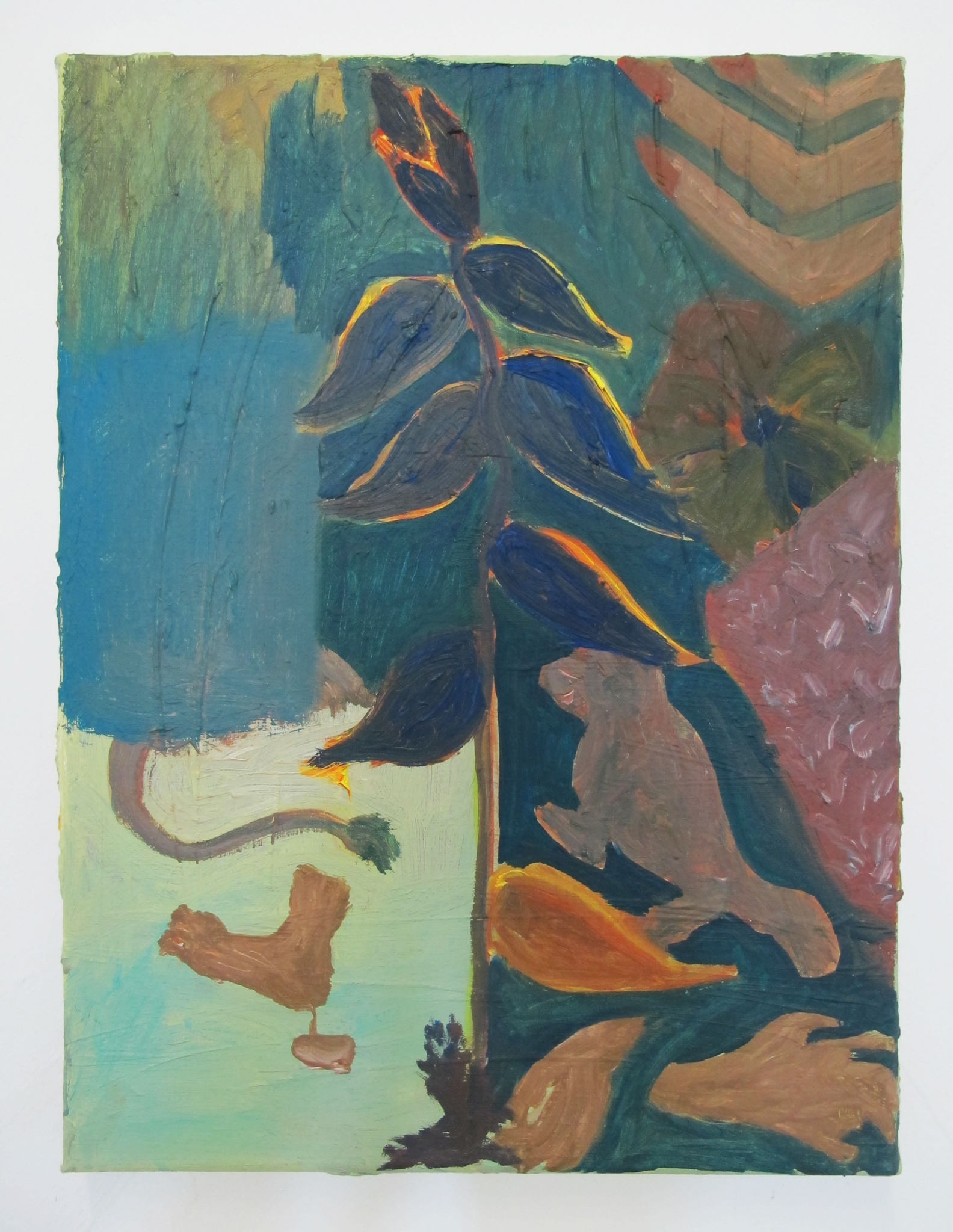
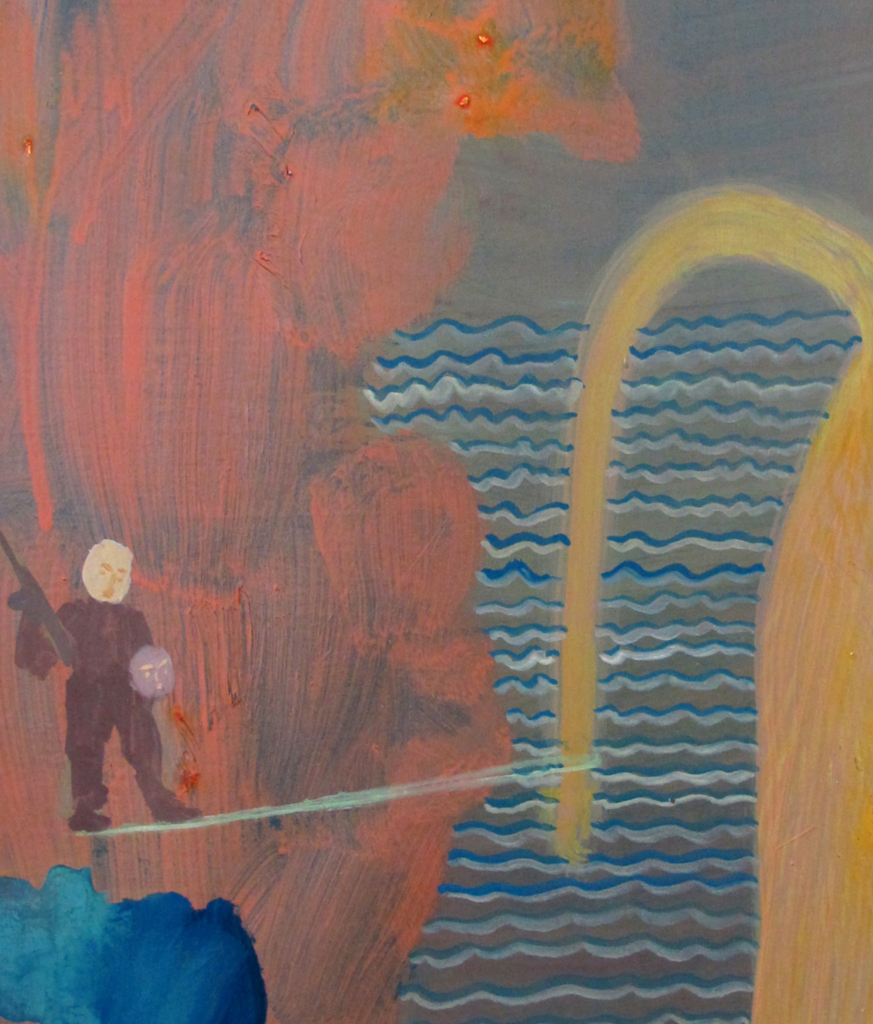
Droomland
10.09–11.12.2022
Marie Zolamian
Droomland
10.09–11.12.2022
Save the date for the finnisage: Sunday 11.12.22
This autumn, we proudly present Marie Zolamian’s (°1975, LB) new monumental work during Droomland*, her solo exhibition at Jester. Her work finds itself at the distinction between colourful, familiar scenes, art historical references, and a déjà vu-like dreamy world where mysterious silhouettes and creatures appear. Like a fictitious ethnologist she keeps an observational images diary, for which she draws inspiration from daydreaming, testimonies, local history or cultural customs linked to the place from which she works.
In preparation for her solo presentation at Jester, the artist briefly stayed at the Emile Van Dorenmuseum, where she soaked up the stories that enfolded the Genk tradition of landscape painting. Here, ‘Bezoekt droomland Genk’ (translated as ‘Visit dreamland Genk’), a slogan from an old tourist advertisement, caught her attention. Buried in the city’s recent mining and industrial past, one would almost forget that at the end of the 19th and the beginning of the 20th century Genk was known as a ‘station d’artistes’, where the vast nature and rustic life appealed to the imagination and attracted visitors, especially artists, from home and abroad. To this day, this post-industrial region boasts enormous biodiversity in and around its various nature reserves. For Zolamian, nature is imaginary. Her pictorial semblance celebrates diversity and crossing, which for her are a pretext for painting.
For Droomland, the artist takes over Jester’s exhibition space. While in the studio smaller canvases are a familiar starting point, Zolamian will work in situ on a monumental creation in the weeks before the opening. Layer after layer, a landscape will be shaped. Playing with camouflage, approach and resistance, this large-scale work offer – despite its scale – an intimate glimpse into the mysterious universe expressed in Zolamian’s oeuvre.
*Droomland means dreamland
Admonestation, 2022.
Oil on canvas on panel, 41 x 31 cm.
Image by courtesy of Marie Zolamian
PRACTICAL INFORMATION:
On Saturday, the 10th of September, the opening takes place between 3 and 7 p.m. You can find our presentation space on the 1st floor of the C-mine energy building. Droomland is on view, every day except on Mondays, from 10 a.m. till 5 p.m. The show runs until the 11th of December.
Related Projects
Art Trip Marie Zolamian
28.10.2022


Riding High in the Reading Saddle
21.05–07.08.2022
Alexis Gautier
Riding High in the Reading Saddle
21.05–07.08.2022
Guided tour: Sunday,
07.08, 4 p.m.
Alexis Gautier’s work explores the relationships at play in cultural transactions, collaborations and the creation of narratives. Often made with other individuals, his work creates a space for exchanges and appropriation, weaving encounters, discoveries and misunderstandings. Gautier documents his research and interventions through textiles, sculptures, videos, narrations and drawings. FLACC/CIAP invites the artist to continue his research during his residency in Genk, which will culminate in a solo exhibition in May 2022.
Guided tour: Sunday, 07.08, 4 p.m.
During the finissage of Riding High in the Reading Saddle, join us for the guided tour of the exhibition.Jester’s artistic director Orlando Maaike Gouwenberg will be your guide through the work of Alexis Gautier and the unique indoor and outdoor spaces at the C-mine site. The meeting point is the visitor’s desk at C-mine.
Alexis Gautier (FR) is currently a resident at WIELS (Brussels) and an affiliated researcher in the arts at the Royal Academy of Fine Arts in Antwerp. He graduated from the Städelschule in Frankfurt am Main (DE) and from the Royal Academy of Fine Arts of Antwerp (BE). He had solo exhibitions at Museum M Leuven (2021), ISLAND (Brussels, 2020), Basis (Frankfurt Am Main, 2019), Blue Mountain School (London, 2018) and BOZAR (Brussels, 2017). He was awarded the Günther-Peill Stiftung (Düren, DE) and is supported by the Fondation des Artistes (Paris, FR) and by the Flemish Community.
.







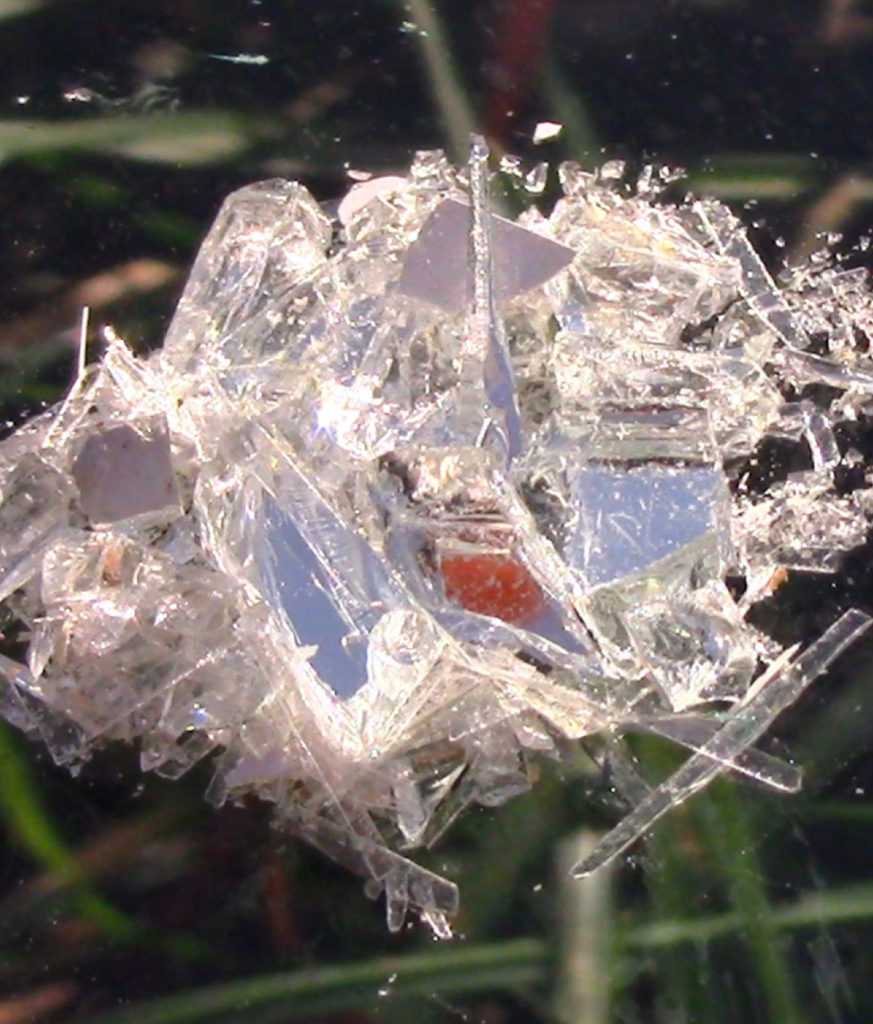
Three Tropes for Entropy
05.02–01.05.2022
Lichen Curatorial Prize
Three Tropes for Entropy
05.02–01.05.2022
Until the 1st of May, you can discover the works of the 2nd trope in the C-mine compressors hall.
With works by mountaincutters (FR), Angyvir Padilla (VZ) and Daniel Steegmann Mangrané (ES), Three Tropes for Entropy delves into three distinctive artistic practices, presenting their singular approaches towards notions of flux, energy, and transformation.
Laila Melchior and Koi Persyn — laureates of the second edition of the Lichen Curatorial Prize — present a transformative exhibition connecting three artistic practices and methodologies to the unique site of the former Winterslag coal mine. Having hosted an industrial complex of coal exploitation for approximately a century, this former mine site embodies the capacity to generate and process energy not only through its history but also in its recent transformation into a creative hub.

Daniel Steegmann Mangrané, Phasmides
16mm film transferred to HD video, color, mute,
22’41”, 2012, Courtesy Mendes Wood DM, São Paulo and Esther Schipper, Berlin
‘Trope’ and ‘entropy’ share the same ancient Greek root in the word τροπή, evoking the ideas of turn and transmutation. Tropes are literary motifs that use figurative forms of language to increase the tangibility of meaning, stimulating associative perceptions. Entropy is a term that has gained momentum in current times. A scientific concept that stems from thermodynamics, it indicates a transmission process within a closed circuit. Drawing from this specific usage to a more general one, it has been widely used to exemplify the irreversibility of time, of processes that have a clear start but no defined end and that can become quite invisible, as much as they are omnipresent.
In parallel with and inspired by such a mixture of possible approaches to the phenomenon of transformation, the exhibition itself undergoes a change over its course. Three Tropes for Entropy opens with clusters of works highlighting each participating practice and gradually evolves towards an intermingled diffusion of particles. These transformations will be marked by three activated moments or chapters – identified by the curatorial duo as exhibition’s ‘tropes’:
risquer sa mutation :
programme d’une pensée sans domaine
05.02 – 03.04.2022
Ella es su espejo incendiado, su espera en hogueras frías.
05.03 – 01.05.2022
Eu era gases puro, ar, espaço vazio, tempo.
01.05.2022 – …
These gradual changes allow for interactions between the works themselves and the space, modulating intensities to render visible the mutability that circulates inside the engines of practices.
Film Programme
Three films presented during the opening weekend of Three Tropes for Entropy can now be watched below. The screening was part of risquer sa mutation : programme d’une pensée sans domaine, the exhibition’s first trope.
-
- Daniel Steegmann Mangrané, Phasmides, 2012; 22’41”, 16 mm transferred to HD, colour, mute, courtesy of Mendes Wood DM, São Paulo and Esther Schipper, Berlin
- Angyvir Padilla, 21 años de mala suerte (21 years of bad luck), 2014; 04’04“, colour, sound, courtesy of the artist
- mountaincutters, Supplique pour le beau temps, 16 mm transferred to HD, colour, mute, 2’08”, 2021, production by fondation d’entreprise Hermès
The artists
mountaincutters (FR, °1990) is a hybrid identity, living and working in Brussels. Their duo-practice consists mainly of site-specific sculptures that reconfigure the space where they are exhibited. Through poetic texts and analogue photographs, the duo often finds historical and/or material leads that form the basis of their sculptural installations. These constellations of glass, ceramic, copper and metal objects are in constant flux, forming a closed circuit between the different entities. The in-situ works balance on the threshold of inactive and dynamic, present and invisible, rough and refined. Like an echo of this confused identity, the installation adds an aesthetic uncertainty, favouring transitory situations and unfinished forms for seemingly fortuitous compositions. mountaincutters unifies phenomena that are considered incompatible into one coherent volume, therefore pushing the boundaries of the sculptural into conflict.
Angyvir Padilla (VZ, °1987) lives and works in Brussels. In her practice, she invites the viewer to look closer at the places we inhabit by examining how we embody memory. Padilla proposes that the traces of our past seep into a persistent present. Her immersive installations distil the concept of ‘home’ as an intimate, secluded place and relate this notion to people and nature. Padilla’s practice explores the discrepancies and intervals between identity, material and space. Her work turns around the sense of otherness one encounters once presence enters into a dialogue. Angyvir Padilla often works presenting objects and processing materials in relation to the spatial environment in order to connect emotionally with the viewer.
Daniel Steegmann Mangrané (ES, °1977) lives and works in Rio de Janeiro. His research is composed of subtle yet crude experiments that question the relationship between language and the world. Although primarily conceptual, his installations engage with the spectator’s imagination and exhibit a strong concern with the existence of everything we see, but especially on everything that we do not see. Mangrané’s work often traces the boundary where nature meets artifice. Lines, circles and rhombuses are drawn, cut and projected onto leaves; the delicate symmetry of branches is split in two. These precise interventions hold a powerful force of attraction: a moment of uncertainty between what is contrived and what is natural. In each of Steegmann Mangrané’s intricate compositions, we get to experience that, far from being distinct, the organic and the geometric, the vital and the abstract, define each other.
The curators
Laila Melchior is an independent curator and researcher investigating the fields of contemporary art and audiovisual aesthetics. She holds a master’s degree in Communication and Culture from UFRJ (BR) and a postgraduate degree in Curatorial Studies from The Royal Academy of Fine Arts (KASK). Laila Melchior works on projects related to arts, film and theory, looking to incorporate perspectives from the Global South into her projects. As a curator, she collaborates with art institutions. Some of her recent projects are the exhibitions Trojan Horse Behind Glass; Time, Times. Half a Time; and The Ghost Library. She is one of the founders and part of the curatorial board of Aventuras do Pensamento, a series of encounters between a children-composed audience and some of the greatest contemporary Brazilian thinkers, scientists and artists that since 2016 discusses pressing issues in the political, innovative and creative horizon of the country. Laila Melchior has also designed the Young Curators Programme, a project which she coordinates to promote a greater engagement of emerging curators in the frame of Belgian participation in the Venice Biennale. Formerly a lecturer at the undergraduate course in Cinema and Digital Media at IESB (Brasilia – BR), she has also published and presented academic works.
Koi Persyn is a Brussels-based independent curator and visual artist. He obtained a master’s in Fine Arts at The Royal Academy of Fine Arts (KASK) after which he completed a postgraduate in Curatorial Studies, also at KASK. During his studies, Koi Persyn founded and co-curated STOCK, a three-year-running residency programme in Het Paviljoen, Ghent. His artistic and curatorial trajectory encompasses notions of authorship and collectivity, employing experimentation with exhibition formats in unconventional locations. His curatorial projects focus on process-based, experimental, and interdisciplinary practices through open-air, collaborative, site-specific exhibitions and residency programmes. Koi Persyn participated in the exchange programme with BIDAI college of arts in Kanazawa (JP) and worked in the framework of the Young Curators Program as a mediator for the Belgian Pavilion at the 58th edition of the Venice Biennale. Koi Persyn co-curated Publiek Park, an open-air group exhibition in the Citadelpark of Ghent, as part of his activities in the frame of the Young Friends of S.M.A.K. Currently, Persyn develops the annual programme of Komplot in Brussels as a guest curator.
Lichen is a prize for emerging curators, established by CIAP platform for contemporary art and the department of Curatorial Studies at KASK School of Arts to foster and support curatorial experimentation in Belgium. With the support of the Flemish Community, the City of Genk, and the CIAP members.
Related Projects
Petrichor
13.09–08.11.2020

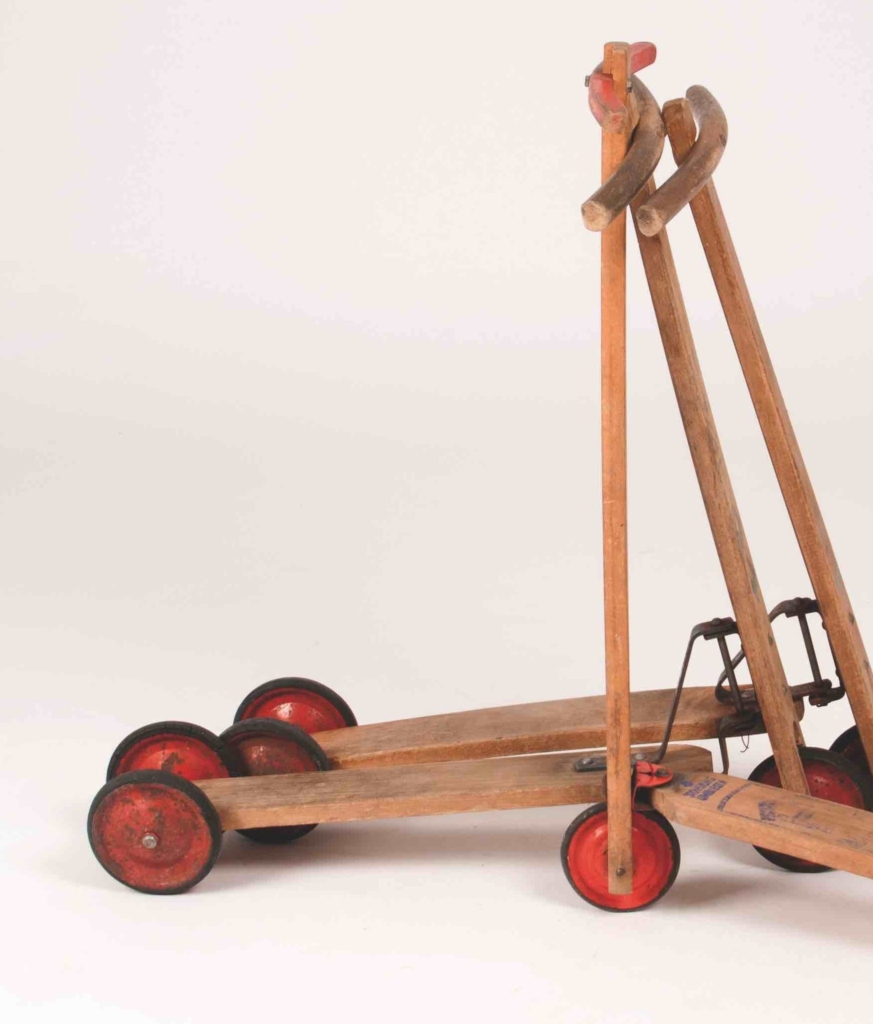
Mine de rien
23.10.2021–16.01.2022
Marianne Berenhaut
Mine de rien
23.10.2021–16.01.2022
Marianne Berenhaut’s body of work, spanning over five decades and still expanding, eludes any attempt at a summary. It cannot ever be explained or fully grasped; it needs to be seen, experienced and felt to the bone. The exhibition at CIAP and C-mine presents a subjective choice from this generous oeuvre. Sculptures, installations, and collages made of objects found in the artist’s immediate surroundings are accompanied by a selection of archival materials, including previously unseen footage and newly commissioned documentation. Placed side by side, the works created years apart come into dialogue and reveal their lasting relevance. The expression ‘mine de rien’, borrowed for the title of this exhibition, describes someone acting casually, ‘as if nothing was at hand’, much like the works of Marianne. Hidden behind the facade of daily objects are memories and stories we all can relate to, but also experiences that remain deeply individual and, on some level, inaccessible.
The very present, symbolically charged architecture of the former mine of Winterslag lends itself as a perfect setting to highlight specific facets of Marianne’s practice. Now a creative site, it used to be the heart of the extractive industry and a gravitational core of the cité, attracting newcomers to Genk. What better context to reflect on the subjects of care, labour, trauma, and healing, which surface, in a more or less direct way, throughout this body of work.
PRACTICAL
The tickets to this exhibition can be now purchased via C-mine’s website.
FOLLOW THIS LINK to reserve your ticket.
GUIDED TOURS
CIAP organizes three tours guided by the curatorial team. The curators reveal some anecdotes about the works and share their own experiences with Marianne Berenhaut’s oeuvre. Participating in a guided tour is included in your expo ticket. Register via the link below, but do not forget to also purchase a ticket for the exhibition on the same date. The number of places is limited.
Saturday 06.11.21, 2:00 to 3:00 p.m. (English)- Saturday 11.12.21, 2:00 to 3:00 p.m.(Dutch)
- Saturday 08.01.22, 2:00 to 3:00 p.m.(Dutch)
This exhibition is a collaboration between CIAP and C-mine. With the kind support of the Flemish Community, the city of Genk, and CIAP members.
Bio
Marianne Berenhaut (1934, BE) lives and works between Brussels and London. She studied fine arts at the Académie du Midi and Atelier de Moeschal (1960-1964). Her works were presented in various solo exhibitions, at La Maison des Femmes (Brussels), Musée Juif de Belgique (Brussels), MAC’s (Grand Hornu), Isy Brachot Gallery (Brussels), Nadja Vilenne Gallery (Liège), and Island (Brussels). She has been part of several group exhibitions, amongst others at Maison Grégoire (Brussels), Gladstone Gallery (Brussels), Bureau des réalités (Brussels), and Carl Freedman Gallery (Margate, UK). She is represented by Dvir Gallery (Brussels/ Tel Aviv).









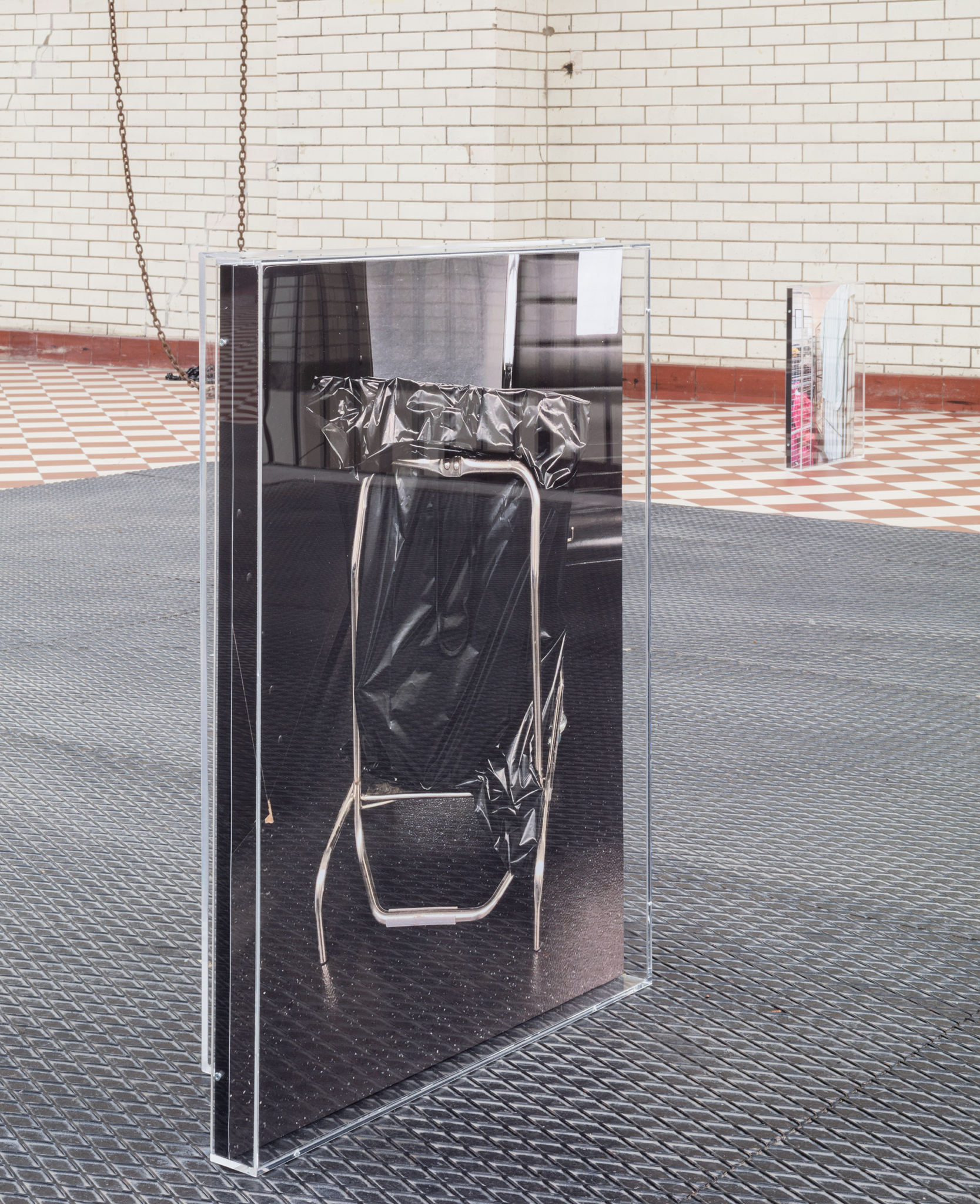

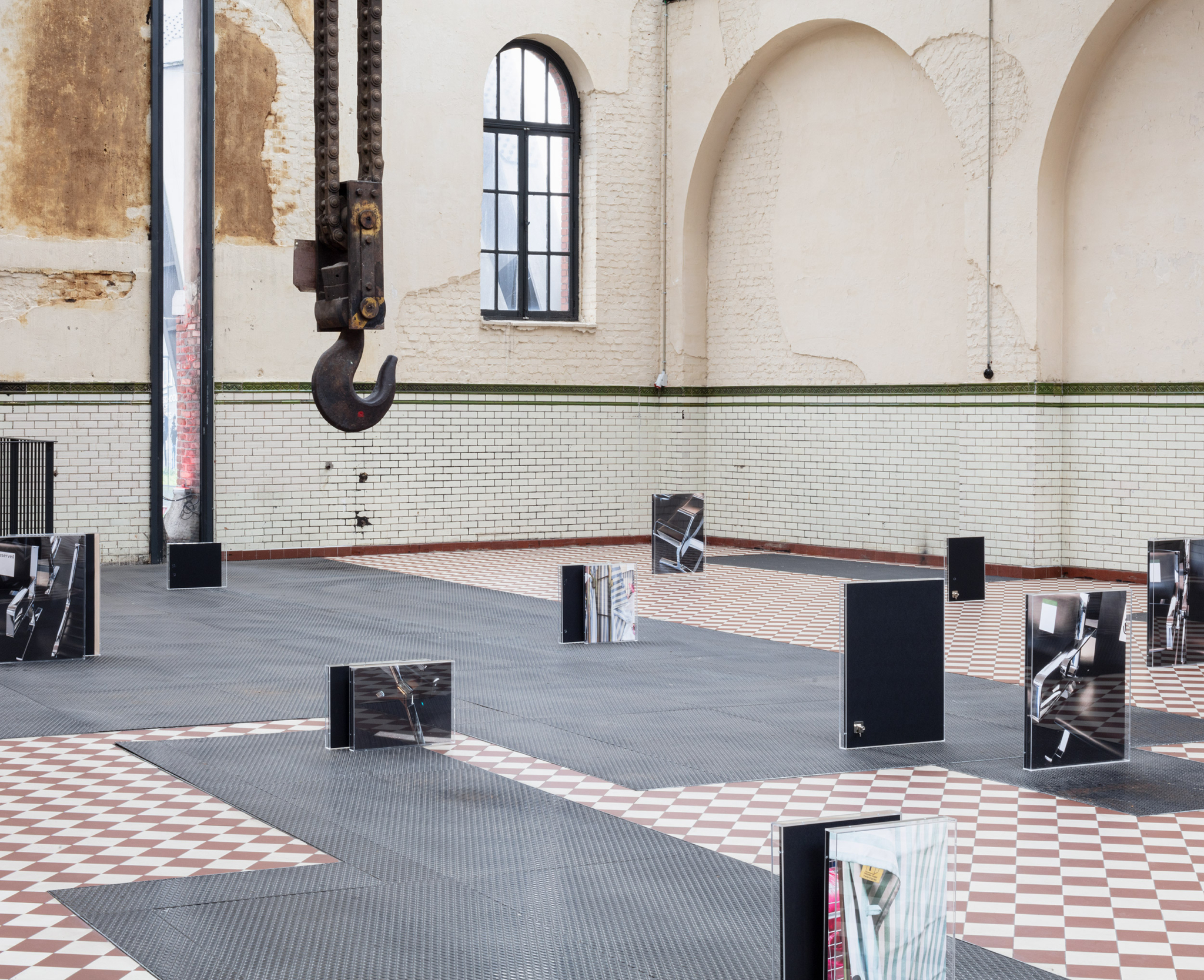




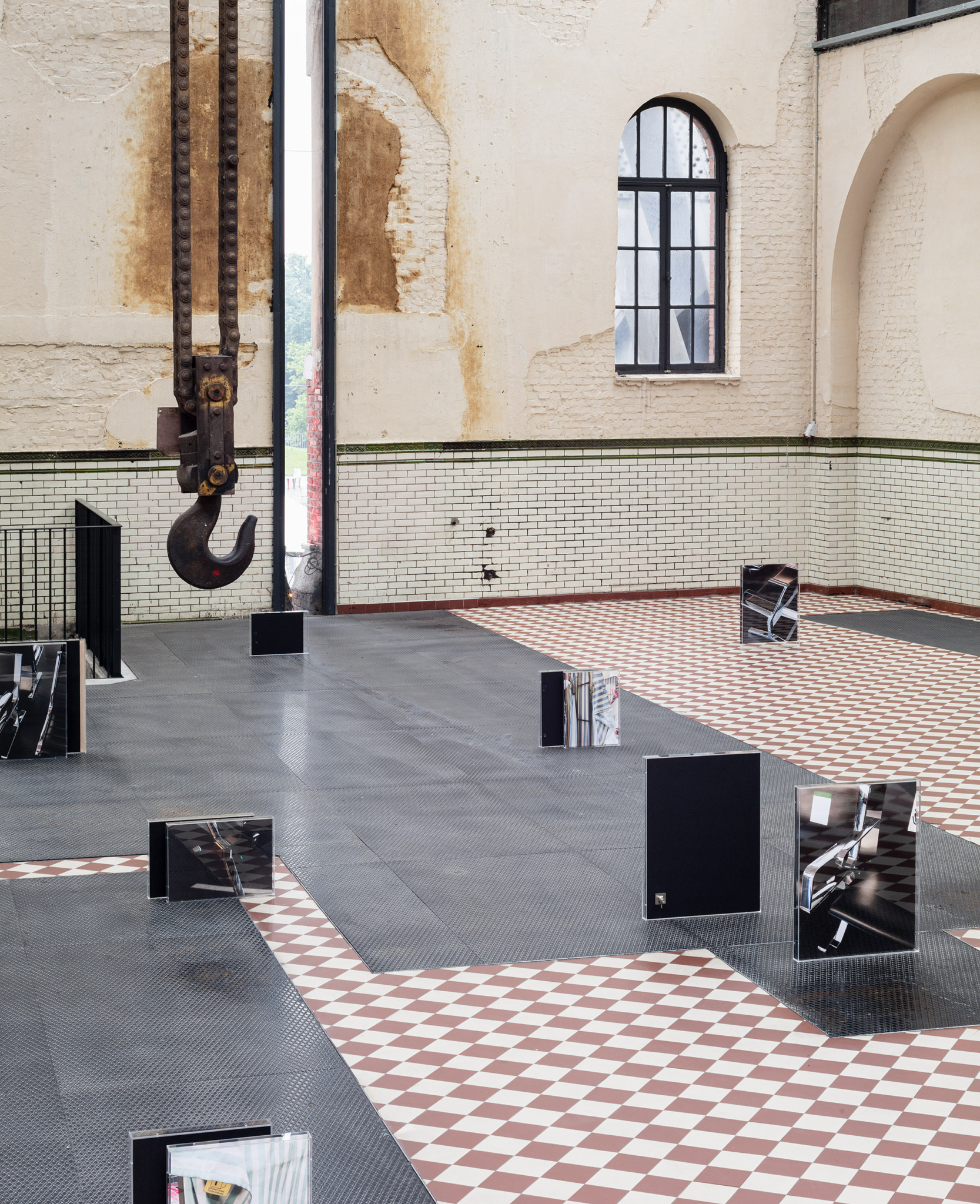


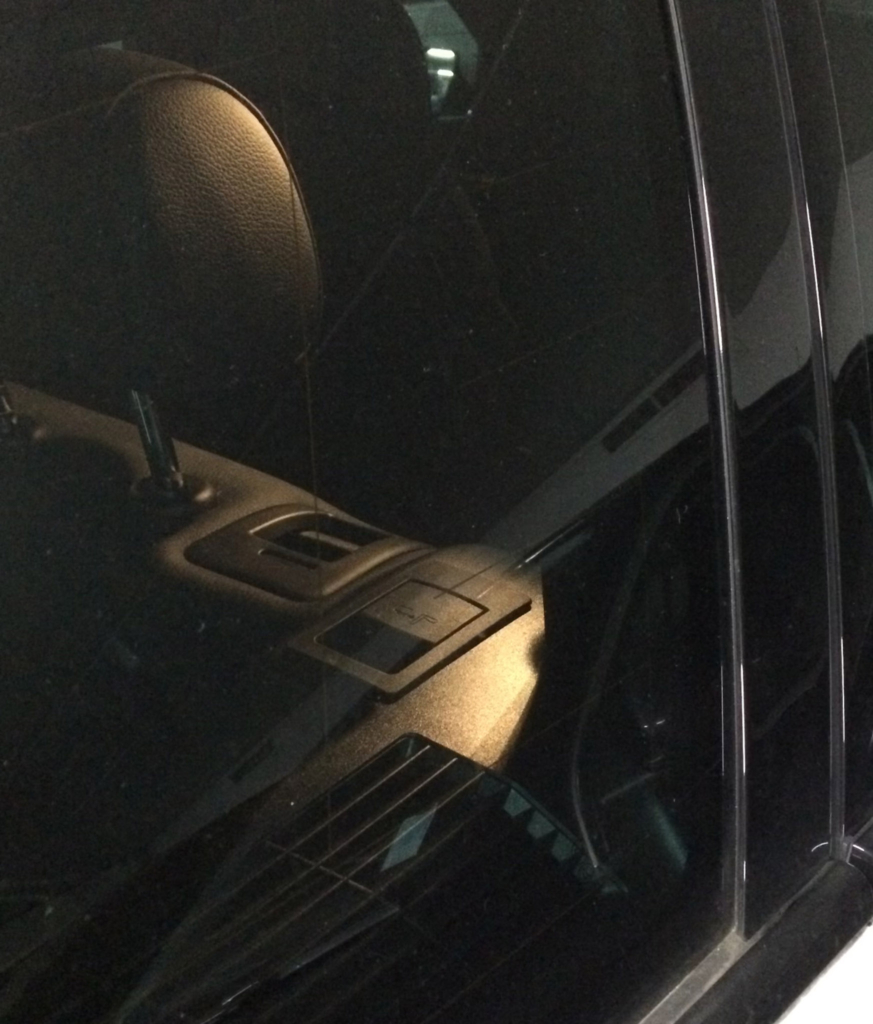
You may never know what's causing all the traffic
19.06–11.09.2021
Marina Sula
You may never know what's causing all the traffic
19.06–11.09.2021
A digital version of the publication accompanying the exhibition can be downloaded here
Marina Sula’s practice spans photography, sculpture, and installation. She appropriates elements from the realms of industry, design, and advertising to construct highly controlled yet ambiguous environments.
Her interest gravitates towards objects and sites that problematise the distinction between original/generic, individual/collective, private/public, such as waiting rooms, offices, and airports. In blending the persuasive, utilitarian language of forms specific to industry and advertising with more intimate registers, her work transmits a similar sense of ambiguity.
In the months leading to the exhibition, the artist amassed a vast archive of ‘poor images’, either snapped with her phone or pulled off of the internet. All of them exhibit the kind of hyperreal, enhanced genericness characteristic of stock footage or ads. These images have been manipulated and transformed using both digital reproduction techniques and manual work and given a physical presence, encased in acrylic boxes or embedded in stainless-steel benches. In the nearly 10-meters-tall former industrial hall, the works are positioned directly on the floor, softly guiding the viewers through the layers of mirroring surfaces and deconstructed images.
Bio:
Marina Sula (1991°, Lezhe, Albania) lives and works in Vienna. She studied Art History at the University of Vienna and photography at the Vienna Academy of Fine Arts. Currently, Sula is an artist-in-residence at Cité Internationale des Arts, Paris. Her solo exhibitions include: I’m Sorry, I can’t, don’t hate me at Gabriele Senn Gallery, Vienna (2019); Warten at Viennacontemporary (2019); After Solitude at the Academy of Fine Arts, Vienna (2018); What is it like.. at Kunstverein Kevin Space, Vienna (2016). Her work has been shown in group exhibitions at: Galerie der Stadt Schwaz (2021); National Gallery, Prishtina (2021); GAM Fondazione Musei, Turin (2020); PCP Gallery, Paris (2020); Kunstverein Kevin Space, Vienna (2020); Nir Altmann, Munich (2020); Kunstforum, Vienna (2020), Belvedere 21 – Museum for Contemporary Art, Vienna (2019); Croy Nielsen, Vienna (2018).
With kind support of Flemish Community, the City of Genk, CIAP’s members and Bundesministerium für Kunst, Kultur, öffentlichen Dienst und Sport in Austria.






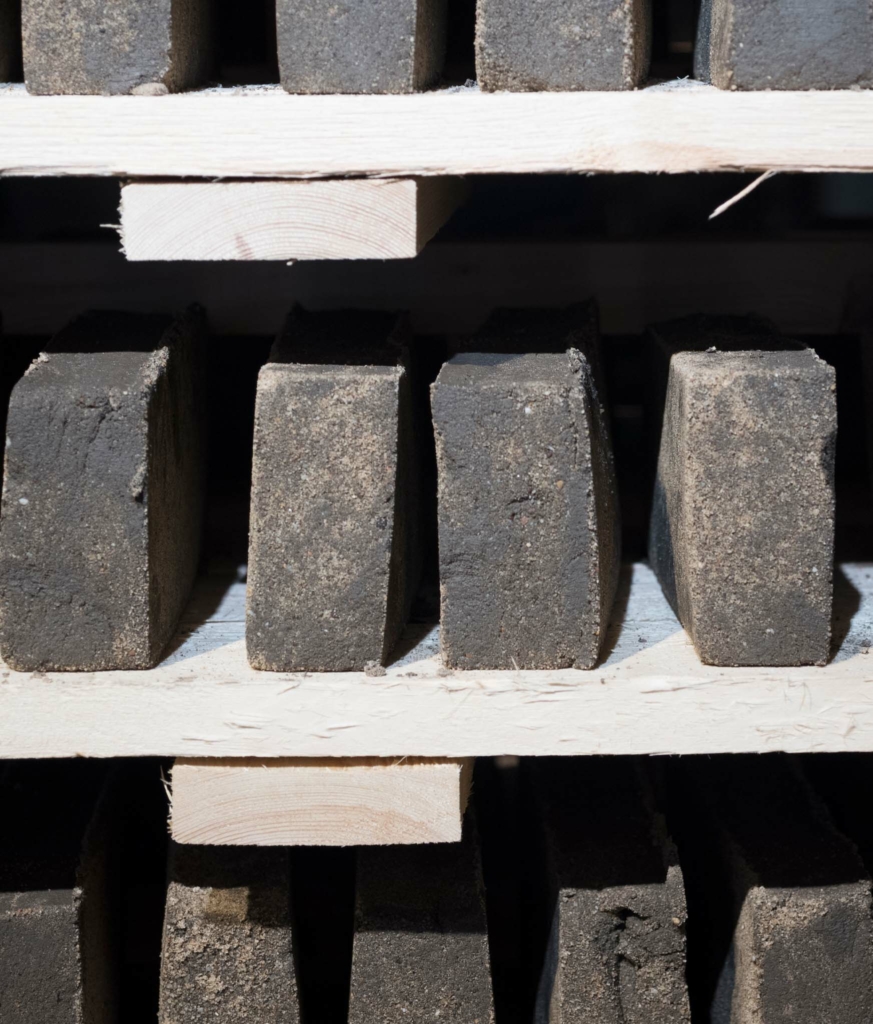
Le Paysage Ménagé #2
28.03–11.05.2021
Ciel Grommen & Maximiliaan Royakkers
Le Paysage Ménagé #2
28.03–11.05.2021
Le Paysage Ménagé is a long-term research project of Ciel Grommen and Maximiliaan Royakkers, developed in collaboration with CIAP and FLACC – workplace for visual artists, inviting us to imagine new ways of being in the landscape and making connections with and within it. Taking the complex, post-industrial landscape of Winterslag as a starting point, the project envisages a series of spatial interventions, or ‘furniture’, which can function as both physical and figurative platforms for dialogue.
To ‘furnish’ a landscape means to create something provisional and flexible, to take a stance without planting a flag or claiming the territory. The first piece to furnish the C-mine site is a temporary brick platform – a unique meeting place where during the day meals and stories are shared and at nights animals and plants take over. Inspired by the Chinese ‘kang’ bed and the Russian ‘pechka’ stove, the platform can be heated up from the inside, emanating warmth and aura of hospitality.
The material used to construct this platform takes its roots in the local history; as the only mining site in Genk, Winterslag operated a brickyard, where the residue of the mining process was transformed into building material for the rapidly expanding residential districts. Still today, the characteristic black-charred bricks, known as Winterslagse Duivels (‘the devils of Winterslag’), clad the facades all over the neighbourhood.
With the support of passionate experts and amateurs, Grommen and Royakkers have developed a parallel brick-making technique, using the so-called ‘minestone’ – a mixture of sand, clay, and water, present in the ground and officially considered ‘waste material’. Those bricks are hand-formed, air-dried, and fired on-site, in a temporary field oven. With every baking cycle, this low-tech oven is assembled and disassembled again.
Every step in this slow production process takes place in the public space. The baking cycles become an opportunity to experiment, to exchange knowledge, and to engage in conversations about the local landscape with the visitors, neighbours, fellow artists, and
passers-by.
Where to see the work-in-progress?
We invite you to follow the project online, on our social media and our website, or come by C-mine to see the work-in-progress. In late February, Grommen and Royakkers will set up a temporary open-air brickyard at the foot of the terril (slag heap) adjacent to C-mine.
The artists will be working on the site during the baking cycles on the following dates:
28/03 – 31/03
18/04 – 22/04
07/05 – 11/05
In May, the bricks will be used to construct the daybed, in which forms, techniques, and materials inspired by both distant and local traditions come together; a concept which resonates with the multicultural character of Genk. In June, we plan a special inauguration of the platform, with an exciting public programme. More info will follow soon.
The project is realised in co-production with FLACC — workplace for visual artists. With the support of the Flemish Community, the City of Genk, and CIAP members. Le paysage Ménagé is part of the ELEMENTS partnership in which contemporary art and cultural institutions in Dutch Limburg, Belgian Limburg and Liège program around an ‘element’ associated with the region.
Related Projects
Le Paysage Ménagé #1
13.09–08.11.2020

















photo: Michiel De Cleene





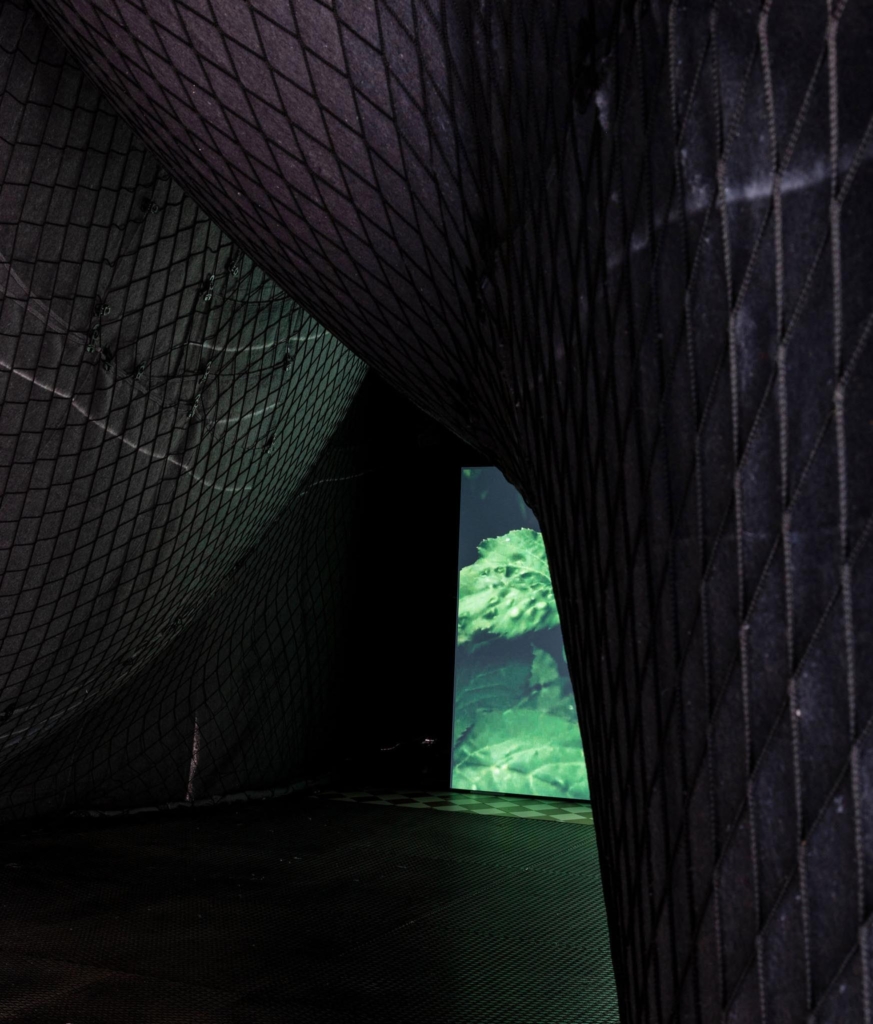
A Demonstration
17.01–14.03.2021
Sasha Litvintseva & Beny Wagner
A Demonstration
17.01–14.03.2021
in collaboration with Chevalier-Masson, Point Supreme & 51N4E
A Demonstration is a monster film with no monsters. Inspired by the existence of taxonomies of monsters at the heart of early modern European science, the film explores and reinterprets a way of seeing the natural world that is almost impossible to imagine from today’s vantage point. Early Modern naturalists were guided by a logic in which truths were discovered through visual analogy. The word ‘monster’ comes from the latin ‘monstrare’, meaning to show, to reveal, to demonstrate. A Demonstration picks up on these themes in a poetic exploration of the boundaries of sight and the metamorphosis of form.
Presented for the first time in the exhibition setting, the film comes into a dialogue with scenography designed by textile designers Chevalier-Masson (Brussels) in collaboration with architectural offices 51N4E (Brussels) and Point Supreme (Athens). Set in the vast, emptied-out machinery hall at C-mine, a former mining site, this temporary, three-dimensional structure generates a sense of spatial and architectural destabilisation. Much like the grottos and follies of Mannerist gardens, it explores the architecture’s ability to affect the body, to show and conceal, to guide and mislead.
Bio:
Sasha Litvintseva and Beny Wagner are artists, filmmakers, researchers and writers. They’ve been working collaboratively in moving image, text, and lectures since 2017. Focussing on moving image as a tool for the active production of new worlds, their practice has been driven by questions about the thresholds between the body and its surroundings, knowledge regimes and power, modes of organizing and perceiving the natural world.
Their combined and individual work has been presented globally: Berlinale, Rotterdam, Courtisane, Cinema Du Reel, RIDM, Ann Arbor, Alchemy and Guanajuato film festivals, Eye Film Museum, HKW Berlin, ICA London, CAC Vilnius, Museum of Contemporary Art Chicago, Berlinische Galerie, MUMOK Vienna, Sonic Acts, Impakt Festival, Berlin Atonal and the Videobrasil, Moscow Young Art, Wroclaw Media Art, Venice Art and Venice Architecture biennales.
Wagner is a lecturer of fine arts at Gerrit Rietveld Academy, Amsterdam and Litvintseva is a lecturer in film at Queen Mary University of London.
With the support of the Flemish Community, the City of Genk, C-mine Cultuurcentrum, and CIAP members.
Related projects

photos: Stefanie Schaut






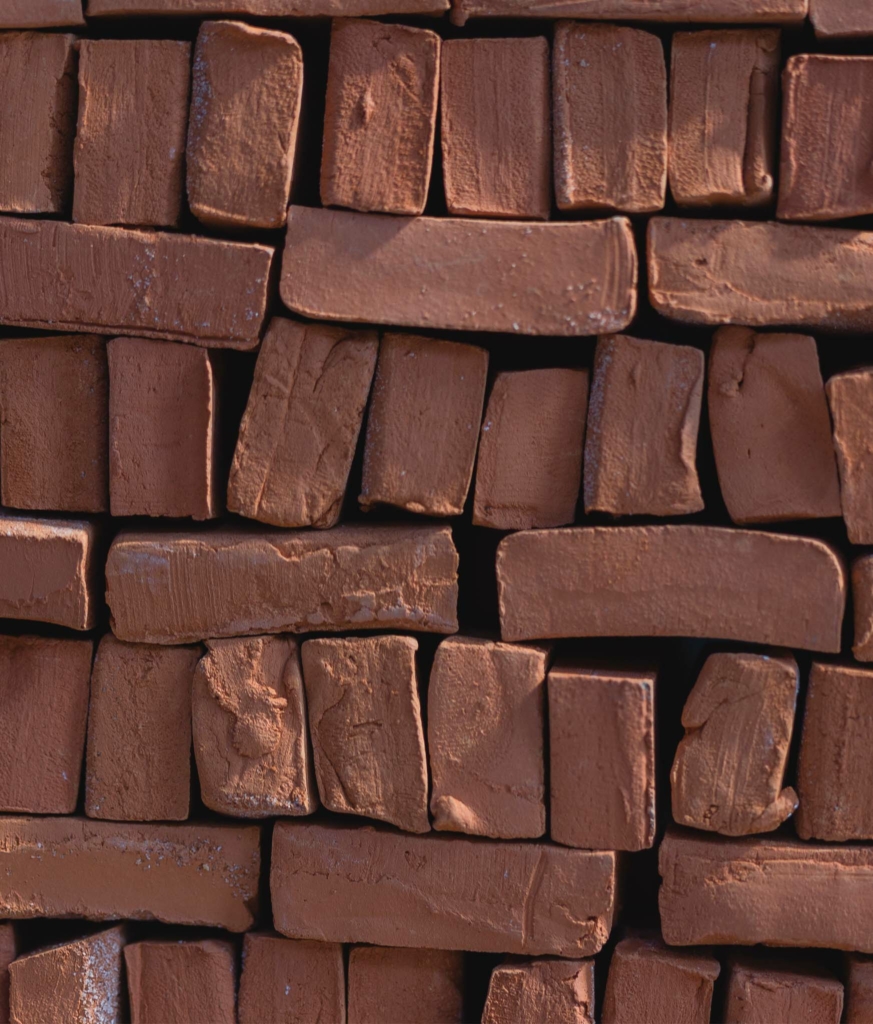
Le Paysage Ménagé #1
13.09–08.11.2020
Ciel Grommen & Maximiliaan Royakkers
Le Paysage Ménagé #1
13.09–08.11.2020
Can we create architecture that does not occupy a site but inhabits it? How do you set your proverbial foot in the landscape without trampling it? And what if it has already been trampled? These are some of the questions that kept us awake at night for over a year now.
Wide awake with us were Ciel Grommen and Maximiliaan Royakkers, a duo of artists/architects, who in 2020 joined CIAP in the endeavour of making the C-mine site and the surrounding landscape our new home. At the moment, CIAP finds itself at the point of multiple transitions, in-between institutional models, infrastructures, and locations. This complex situation, as well as the transient character of the post-industrial landscape itself, were the main starting points for the project.
In the summer of 2019, Grommen and Royakkers initiated an extensive fieldwork at C-mine site in Winterslag (Genk), surveying its polyphonic rhythm and unearthing possible intersections between our needs and those of the landscape. To best understand the intricate context at hand, the duo has reached out to different actors with close ties to the place: from the shepherd herding his stock at the site to truck drivers using it as their temporary rest-stop to botanists and geologists exploring what happens both under and above the disturbed soil. The research has gradually brought to light a great variety of often overlooked practices and species, such as the pioneering vegetation or unique insects, indwelling this seemingly vacant landscape.
Based on these findings, Grommen and Royakkers proposed a cycle of spatial interventions taking into account the unrecognised qualities of the landscape and the resources already present on site. The title of the project, Le Paysage Ménagé (literally, ‘a household landscape’), is a wordplay in the French expression un paysage aménagé (‘constructed landscape’). The removal of the prefix ‘-a’ shifts the emphasis from artificially constructing the landscape to inhabiting and taking care of it.
Le Paysage Ménagé involves the development of two complementary, physical structures for living, working, and making. The aim of the project is not only to install the figurative ‘mailbox’, marking the physical presence of CIAP on the site, but to enter into a dialogue with the local landscape and form new alliances between its different actors (organisations, artists, inhabitants, animals and plants), areas (existing architecture, civic infrastructure, spoil tips, empty lots), and functions (residential, educational, cultural, commercial).
The first spatial intervention will be launched in September 2020 and will take the form of a ceramic fireplace, inspired by the duo’s research into alternative bioclimatic and vernacular design principles. Conceived as a batch rocket stove — a type of simple, wood-burning stove — it can reach temperatures high enough to bake ceramics, and more specifically, bricks. Grommen and Royakkers will make use of this low-tech solution to bake bricks from soil coming from the adjacent terrils (spoil tips).
In this way, the artists plan to bring new life to the historic brickyard of Winterslag, which as the only mining site in Genk used the leftovers of their operation to produce building material. This unique practice transformed Winterslag from the site of extraction, emptying geological layers, into the site of production, using waste as a starting point for material transformation. Still today, the characteristic black-charred bricks, known as Winterslagse duivels (‘the devils of Winterslag’), clad the facades all over the neighbourhood.
In a slow layering process spanning over several months, Grommen and Royakkers will use the freshly produced bricks to build the ceramic structure surrounding the stove. This structure and the surrounding warm atmosphere will offer comfort to different inhabitants: people gathering over food but also birds and insects seeking shelter in the structure’s nooks and crannies. Le Paysage Ménagé lays the foundations for the new house for CIAP (and soon also FLACC) at C-mine.
Bio:
Ciel Grommen (°1989, Sint-Truiden) and Maximiliaan Royakkers (°1988, Hasselt) are a duo of artists/architects, whose work on the threshold of artistic research, education and spatial design questions present social, political and ecological dynamics. Taking complex social contexts and often disturbed landscapes as a starting point, Grommen and Royakkers develop their projects through extensive fieldwork, spatial interventions, and other interactive, participatory formats. Their role as spatial practitioners involves weaving of new narratives into spaces and testing out alternative ways of living-together, inhabiting, and relating to our environments. Ciel Grommen extended her training in architecture at the University of Leuven (2012) with a Master in contemporary art at the HEAD in Geneva (2015). Her works have been exhibited internationally, amongst others in Artsonje Art Centre, Seoul; Live In Your Head Gallery, Geneva; and Z33 in Hasselt; but even more often, they appeared in the non-institutional context, such as Petit Chateau, the asylum centre in Brussels, the post box of her neighbour, the Aldi parking lot of Borgloon, and online. Maximiliaan Royakkers also graduated as an architect from the University of Leuven (2012) and obtained a master’s from the Studio for Immediate Spaces at the Sandberg Institute in Amsterdam (2014). His work spans projects of design, artistic research, teaching and educational experiments and contributing to magazines and editorial projects. His works have been presented by Bureau Europa and Jan Van Eyck Academie, Maastricht; De Singel Antwerp; Bozar, Brussels; Z33, Hasselt; and Stroom, Den Haag.
The project is realised in co-production with FLACC — workplace for visual artists. With the support of the Flemish Community, the City of Genk, and CIAP members.
Related projects
Related Projects
Le Paysage Ménagé #2
28.03–11.05.2021

photos: Stefanie Schaut














photos: Stefanie Schaut

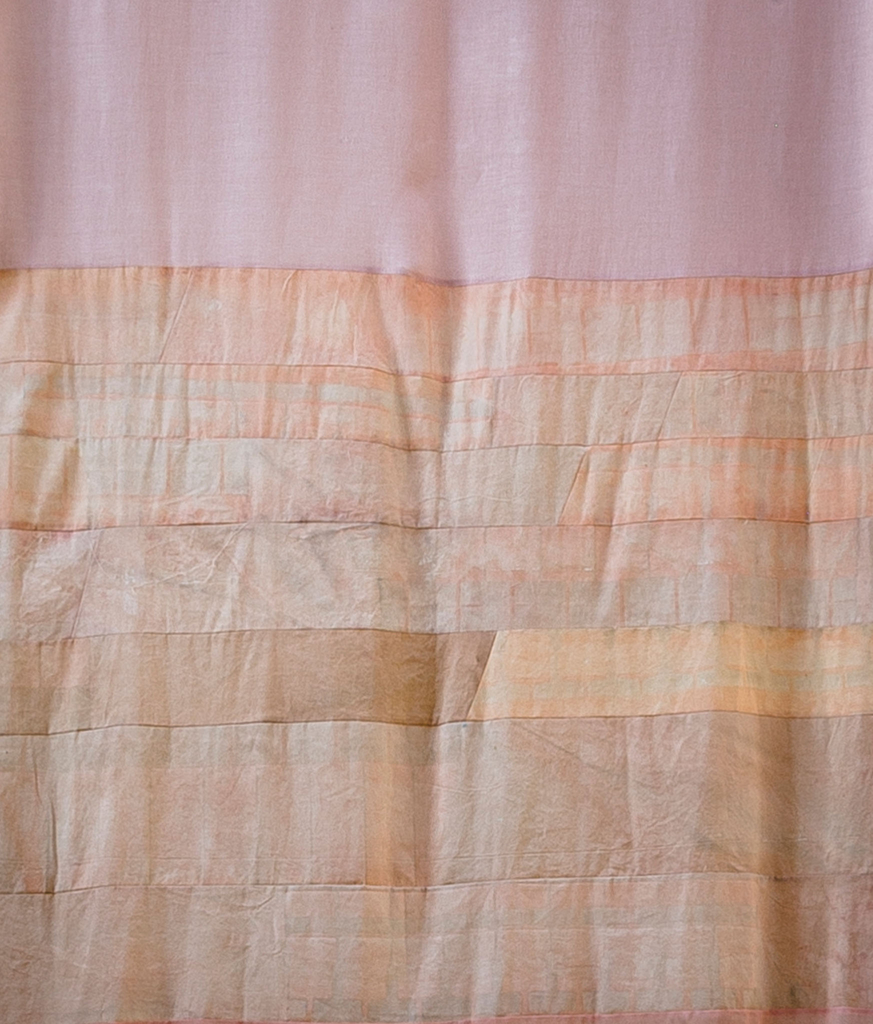
Petrichor
13.09–08.11.2020
Lichen Curatorial Prize
Petrichor
13.09–08.11.2020
A group exhibition with Félicia Atkinson, Ismaïl Bahri, Sina Hensel, Bárbara Prada and Luca Vanello, curated by Lichen Prize laureate Lucie Ménard.
Lichen is a prize for emerging curators, established by CIAP platform for contemporary art and the department of Curatorial Studies at KASK School of Arts to foster and support curatorial experimentation in Belgium. Lichen works with an open call and a jury of experts and prize provides the winner with an opportunity to realise their curatorial project at CIAP, with financial, logistic, and conceptual support of the team.
This year, CIAP and KASK proudly present a group exhibition Petrichor, curated by the laureate of the 2019 edition, Lucie Ménard.
Named after the heady scent emanating from the dry soil during the summer rain, Petrichor echoes the evanescent character of the artistic practices included in the exhibition. It is a celebration of micro-phenomena, inviting us to slow down and focus on the almost imperceptible processes that surround us at every given moment.
A gesture that might seem simple but holds deep political implications, especially today, in the face of the global slowdown caused by the pandemic. As the world stands still, our relationship to labour and productivity is disrupted. What if this forced stop would become an occasion to unlearn and to become aware anew of what surrounds us?
Crystallising or distorting, accelerating or slowing down, the invited artists explore, each in their own way, different strategies of dealing with the temporalities that both surround and compose us. They remind us that we ourselves are temporalities in constant movement, the aggregates of intimate memories and sensory experiences.
Luca Vanello (°1986, Trieste) combines perishable and organic materials with durable, synthetic ones to create his hybrid objects. Playing with various ways to alter the life cycles of the materials, he creates sculptures that seem to be frozen in time, neither developing nor deteriorating and in doing so highlights the vulnerability and circularity of all living organisms.
In the works of Ismaïl Bahri(°1978, Tunis), the seemingly mundane acts, such as water dripping slowly on the floor or a piece of paper fluttering in the wind, become objects of amazement. Working with a basic formal and visual vocabulary and variations thereof, the artist attempts to circumscribe ephemeral phenomena through the simplest gestures.
Sina Hensel (°1986, Mainz) and Bárbara Prada (°1990, Lima) work with organic materials, whose vitality and impermanence play a crucial role in their artistic practices. Hensel shares her studio with various species of plants, algae and other organisms that partake in her creative process. The acts of researching, nurturing, and harvesting are all embedded in the layers of her paintings, which just like natural pigments she uses, alter with time and changing atmospheric conditions. Prada’s practice revolves around food and the stories surrounding it, including forgotten recipes and bits and pieces of vernacular knowledge. She is particularly interested in how food can help us reconnect with our past and relate differently to the present.
Félicia Atkinson’s (°1981, Paris) soundscapes are compositions of different elements, such as spoken language and sounds recorded in-situ, which generate a specific ambience, transporting the listener to another place. The encounter with the work might not take place when one is facing it, she says. We always bring back something precious with us, like a secret slipped into our pocket.
Bio:
Lucie Ménard (°1987, Caen) is an independent curator living in Lille. She is a 2019 alumna of the international post-graduate program Curatorial Studies at KASK School of Arts, Ghent, where she co-curated Weekend at Charlie’s, an exhibition about the collection of architect Charles Vandenhove and Harbinger: Subtle collision, an exhibition about prediction in art and science, in collaboration with art@CERN in Geneva. In summer 2019, while on residency in Kanazawa (Japan), she developed a project mapping the artistic scenes of the twin cities of Ghent and Kanazawa. Since 2012, she has worked as the head of education programmes at Le Fresnoy — Studio national des arts contemporains in Tourcoing. She is one of the co-founders of moss, a cross-border collective for curatorial projects founded in 2020 in Ghent with Lieselotte Egtberts, Elisa Maupas and Anna Stoppa.
The project is realised in collaboration with Curatorial Studies at KASK School of Arts. With the support of the Flemish Community, the City of Genk, and CIAP members.
Related projects
Related Projects



